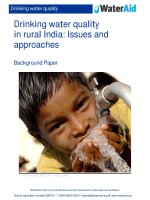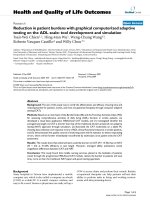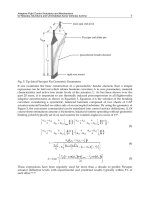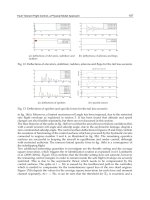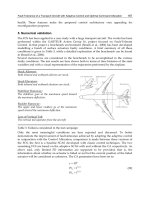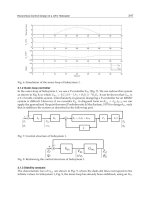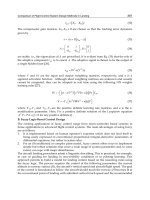Advances in Solid-State Lasers: Development and Applications_1 doc
Bạn đang xem bản rút gọn của tài liệu. Xem và tải ngay bản đầy đủ của tài liệu tại đây (21.26 MB, 288 trang )
Advances in Solid-State Lasers:
Development and Applications
Advances in Solid-State Lasers:
Development and Applications
Edited by
Mikhail Grishin
Intech
IV
Published by Intech
Intech
Olajnica 19/2, 32000 Vukovar, Croatia
Abstracting and non-profit use of the material is permitted with credit to the source. Statements and
opinions expressed in the chapters are these of the individual contributors and not necessarily those of
the editors or publisher. No responsibility is accepted for the accuracy of information contained in the
published articles. Publisher assumes no responsibility liability for any damage or injury to persons or
property arising out of the use of any materials, instructions, methods or ideas contained inside. After
this work has been published by the Intech, authors have the right to republish it, in whole or part, in
any publication of which they are an author or editor, and the make other personal use of the work.
© 2010 Intech
Free online edition of this book you can find under www.sciyo.com
Additional copies can be obtained from:
First published February 2010
Printed in India
Technical Editor: Teodora Smiljanic
Cover designed by Dino Smrekar
Advances in Solid-State Lasers: Development and Applications, Edited by Mikhail Grishin
p. cm.
ISBN 978-953-7619-80-0
Preface
Invention of the solid-state laser has initiated the beginning of the laser era.
Performance of solid-state lasers improved amazingly during five decades. Nowadays,
solid-state lasers remain one of the most rapidly developing branches of laser science and
become an increasingly important tool for modern technology.
This book represents a selection of chapters exhibiting various investigation directions
in the field of solid-state lasers and the cutting edge of related applications. The materials
are contributed by leading researchers and each chapter represents a comprehensive study
reflecting advances in modern laser physics. Considered topics are intended to meet the
needs of both specialists in laser system design and those who use laser techniques in
fundamental science and applied research.
The book begins with the section devoted to new laser media and key components (ch.
1 - ch. 3), followed by theoretical and experimental studies the objective of which was to
improve temporal and spatial performance of mid-infrared lasers (ch. 4, ch. 5). Novel
schemes of side-pumped lasers are also considered in this part of the volume (ch. 6, ch. 7).
Subsequent several chapters describe specific applications of solid-state lasers. In particular,
remote sensing, absolute distance measurement, and ignition of automobile engines are
described in chapters 8 - 10.
Nowadays, development of ultrafast laser systems, including amplification of
ultrashort pulses to high energies, is based mainly on solid-state laser technology. A
substantial part of the volume is devoted to ultrafast phenomena. Amplifying techniques,
including regenerative amplification and optical parametric chirped-pulse amplification, are
described in significant depth (ch. 11 - ch. 13). Modern methods of the femtosecond pulse
characterization as well as the pulse shaping and spectrum control are also considered in
detail (ch. 14 - ch. 18). Impressive achievements in femtosecond lasers intensify
investigations in the scope of the high-field science. In turn, advances in this area allow
development of coherent radiation sources which simultaneously produce extremely short
wavelength (reaching soft X-rays particularly by means of high-order harmonic generation)
and feature the attosecond pulse duration. Moreover, ultra-intense laser pulses provide new
possibilities in the particle acceleration technique. Chapters 19 - 25 cover fundamentals and
development of the laser-based high-field science.
VI
This book is the result of efforts of experts from different countries. I would like to
acknowledge the authors for their contribution to the book. I also wish to acknowledge
Vedran Kordic for indispensable technical assistance in the book preparation and
publishing.
Editor
Mikhail Grishin
Institute of Physics and EKSPLA uab
Vilnius, Lithuania
Contents
Preface V
1. Concentration-Dependent Laser Performance of Yb:YAG Ceramics
and Passively Q-switched Yb:YAG/Cr,Ca:YAG Lasers
001
Jun Dong, Ken-ichi Ueda, Hideki Yagi and Alexander A Kaminskii
2. New Infrared Luminescence from Bi-doped Glasses 025
Yasushi Fujimoto
3. Faraday Isolators for High Average Power Lasers 045
Efim Khazanov
4. Numerical Simulation of High-Power Operation
of 2 μm Co-doped Tm,Ho Solid-State Lasers
073
O. A. Louchev, Y. Urata, M. Yumoto, N. Saito
and S. Wada
5. Actively Q-switched Thulium Lasers 095
Jan K. Jabczynski, Lukasz Gorajek, Waldemar Zendzian,
Jacek Kwiatkowski, Helena Jelinkova,
Jan Sulc and Michal Nemec
6. Efficient Intracavity Beam Combining of Multiple Lasers
in a Composite Cavity
119
Ming Lei
7. Compact, High Brightness and High Repetition Rate
Side-Diode-Pumped Yb:YAG Laser
125
Mikhail A. Yakshin, Viktor A. Fromzel, and Coorg R. Prasad
VIII
8. In-line Typed High-Precision Polarization Lidar for Disaster Prevention 143
Tatsuo Shiina
9. Precision Dimensional Metrology based on a Femtosecond Pulse Laser 169
Jonghan Jin
and Seung-Woo Kim
10. Micro-Solid-State Laser for Ignition of Automobile Engines 195
Masaki Tsunekane, Takayuki Inohara, Kenji Kanehara and Takunori Taira
11. High Gain Solid-State Amplifiers for Picosecond Pulses 213
Antonio Agnesi and Federico Pirzio
12. Dynamics of Continuously Pumped Solid-State
Regenerative Amplifiers
239
Mikhail Grishin and Andrejus Michailovas
13. Toward TW-Peak-Power Single-Cycle IR Fields
for Attosecond Physics and High-Field Science
279
O. D. Mücke, S. Ališauskas, A. J. Verhoef, A. Pugžlys, A. Baltuška,
V. Smilgevičius, J. Pocius, L. Giniūnas, R. Danielius, and N. Forget
14. Measurement and Control of Carrier-Envelope Phase
in Femtosecond Ti:sapphire Laser
301
Zhiyi Wei, Hainian Han, Wei Zhang, Yanying Zhao,
Jiangfeng Zhu, Hao Teng and Qiang Du
15. Pulse Measurement Techniques Using an Acousto-Optic
Programmable Dispersive Filter
319
Nicolas Forget and Thomas Oksenhendler
16. Pulse-Shaping Techniques Theory and Experimental Implementations
for Femtosecond Pulses
347
T. Oksenhendler and N. Forget
17. Femtosecond Filamentation in Temperature Controlled Noble Gas 387
Zhenming Song, Yun Wei, Shiying Cao, Weipeng Kong,
Dongqing Pang, Ruxin Li, Qingyue Wang and Zhigang Zhang
18. Diffraction Gratings for the Selection of Ultrashort Pulses
in the Extreme-Ultraviolet
413
Luca Poletto, Paolo Villoresi and Fabio Frassetto
19. High-Harmonic Generation 439
Kenichi L. Ishikawa
IX
20. High-Order Harmonic Generation from Low-Density Plasma 465
Tsuneyuki Ozaki, Rashid Ganeev, Masayuki Suzuki and Hiroto Kuroda
21. An Attosecond Soft x-ray Nanoprobe:
New Technology for Molecular Imaging
489
Sarah L Stebbings, Jeremy G Frey and William S Brocklesby
22. Relativistic Nonlinear Thomson Scattering:
Toward Intense Attosecond Pulse
509
Kitae Lee, Sang-Young Chung, and Dong-Eon Kim
23. Radiation Dynamics from the Ultra-Intense Field Ionization of Atoms 539
Isaac Ghebregziabher and Barry Walker
24. Laser-based Particle Acceleration 565
Hans-Peter Schlenvoigt, Oliver Jäckel,
Sebastian M. Pfotenhauer, and Malte C. Kaluza
25. Laser-Driven Proton Acceleration Research and Development 609
Alexander S. Pirozhkov, Hiroyuki Daido, Mamiko Nishiuchi and Koichi Ogura
1
Concentration-Dependent Laser Performance of
Yb:YAG Ceramics and Passively Q-switched
Yb:YAG/Cr,Ca:YAG Lasers
Jun Dong
1
, Ken-ichi Ueda
2
, Hideki Yagi
3
and Alexander A Kaminskii
4
1
Department of Electronic Engineering, Xiamen University
2
Institute for Laser Science, University of Electro-Communications
3
Konoshima Chemical Co. Ltd.
4
Institute of Crystallography, Russian Academy of Science
1
P. R. China
2,3
Japan
4
Russia
1. Introduction
Ytterbium doped laser materials have been intensely investigated for developing high
power laser-diode pumped solid-state lasers around 1 μm (Krupke 2000). Yb:YAG as
crystals and polycrystalline ceramics are one of the dominant laser gain media used for
solid-state lasers (Lacovara et al., 1991; Brauch et al., 1995; Bruesselbach et al., 1997; Taira et
al., 1997; Dong et al., 2006) owing to the excellent optical, thermal, chemical and mechanical
properties (Bogomolova et al., 1976). Owing to the small radius difference between yttrium
ions and ytterbium ions (Dobrzycki et al., 2004), Yb:YAG single-crystal doped with different
Yb concentrations can be grown by different crystal growth methods and efficient laser
performance has been achieved (Brauch et al., 1995; Patel et al., 2001; Dong et al., 2006).
Transparent laser ceramics (Lu et al., 2000; Lu et al., 2001; Lu et al., 2002; Takaichi et al.,
2003; Dong et al., 2006) fabricated by the vacuum sintering technique and nanocrystalline
technology (Yanagitani et al., 1998) have been proven to be potential replacements for
counterpart single crystals because they have several remarkable advantages compared with
single-crystal laser materials, such as high concentration and easy fabrication of large-size
ceramics samples, multilayer and multifunctional ceramics laser materials (Yagi et al., 2006;
Dong et al., 2007). Efficient and high power laser operation in Nd
3+
- and Yb
3+
-ions doped
YAG ceramics has been demonstrated (Lu et al., 2002; Dong et al., 2006). Yb:YAG has been a
promising candidate for high-power laser-diode pumped solid-state lasers with rod (Honea
et al., 2000), slab (Rutherford et al., 2000), and thin disk (Giesen et al., 1994; Stewen et al.,
2000) configurations. The quasi-three-level laser system of Yb:YAG requires high pumping
intensity to overcome transparency threshold and achieve efficient laser operation at room
temperature (Dong & Ueda 2005). The thin disk laser has been demonstrated to be a good
way to generate high power with good beam quality owing to the efficiently cooling of gain
medium and good overlap of the pump beam and laser beam (Giesen et al., 1994). However,
in the thin disk case, the pump beam must be folded many times into thin laser gain
Advances in Solid-State Lasers: Development and Applications
2
medium disk with mirrors in order to absorb sufficient pump power, which makes the laser
system extremely complicated. Some applications require that the lasers should be compact
and economic; therefore, the cooling system is eliminated in compact and easily
maintainable laser system. Therefore, laser-diode end-pumped microchip lasers are a better
choice to achieve highly efficient laser operation under high pump power intensity. The
thinner the gain medium, the better the cooling effect, therefore, heavy doped Yb:YAG gain
media are the better choice for such lasers. The development of Yb:YAG ceramics doped
with 1 at.% Yb
3+
ions have been reported (Takaichi et al., 2003), but the efficiency of such
Yb:YAG ceramic laser is low owing to the deficient activator concentration. In principle,
there is no concentration quenching effect in Yb:YAG, however, the unwanted impurities
(such as Er
3+
, Tm
3+
, Ho
3+
, and so on) from raw materials will be deleterious to the laser
performance owing to the high activator doping. Concentration dependent optical
properties and laser performance of Yb:YAG crystals have been reported(Yin et al., 1998;
Qiu et al., 2002; Yang et al., 2002; Dong et al., 2007). The concentration quenching of Yb:YAG
crystals has been investigated and it was found that fluorescence lifetime decreases when
the Yb concentration is greater than 15 at.% and lifetime decreases up to 15% when the Yb
concentration reaches to 25 at.% (Sumida & Fan 1994; Yang et al., 2002). The fluorescence
lifetime of Yb
3+
doped materials is usually affected by the radiative trapping and
concentration quenching effects (M. Ito et al., 2004). Radiative trapping and concentration
quenching effects become stronger with Yb concentration and there is a concentration region
(from 15 to 25 at.% for Yb:YAG crystal), two trends compete each other and consequently
compensate each other, leading to a constant value of measured fluorescence lifetime.
Therefore special technologies have been taken to eliminate the radiative trapping effect
when the fluorescence lifetime is measured for Yb doped materials. Optical-thin samples or
powder sandwiched between two undoped YAG crystals were used to measure the
radiative lifetime of Yb:YAG crystals (Sumida & Fan 1994; Patel et al., 2001). The radiative
lifetime of Yb:YAG crystal was found to decrease with Yb concentration. Optical spectra of
Yb:YAG ceramics doped with different Yb
3+
-lasant concentration (C
Yb
= 9.8, 12, and 20 at.%)
and efficient 9.8 at.% Yb:YAG ceramic microchip lasers (Dong et al., 2006) have been
reported recently. The comparison of laser performance of Yb:YAG ceramic and single-
crystal doped with 20 at.% Yb has been reported (Dong et al., 2007). However, there is no
systematic comparison studies of microchip laser performance of Yb:YAG ceramics and
single-crystal doped with different Yb concentrations.
Compact, high beam quality laser-diode pumped passively Q-switched solid-state lasers
with high peak power are potentially used in optical communications, pollution monitoring,
nonlinear optics, material processing and medical surgery, and so on(Zayhowski 2000).
Passively Q-switched solid-state lasers are usually achieved by using neodymium or
ytterbium doped crystals as gain media and Cr,Ca:YAG as saturable absorber(Zayhowski &
Dill III 1994; Lagatsky et al., 2000; Takaichi et al., 2002; Dong et al., 2006) or semiconductor
saturable absorber mirror (SESAM)(Spuhler et al., 2001) as saturable absorber. Compared
with SESAM, Cr
4+
doped bulk crystals as saturable absorber have several advantages, such
as high damage threshold, low cost, and simplicity. The output pulse energy from passively
Q-switched solid-state lasers is inversely proportional to the emission cross section of gain
medium and reflectivity of the output coupler according to the passively Q-switched
theory(Degnan 1995). Besides the broad absorption spectrum (Bruesselbach et al., 1997),
longer fluorescence lifetime(Sumida & Fan 1994), high quantum efficiency (over 91% with
Concentration-Dependent Laser Performance of Yb:YAG Ceramics
and Passively Q-switched Yb:YAG/Cr,Ca:YAG Lasers
3
pump wavelength of 941 nm and laser wavelength of 1030 nm) (Fan 1993) of Yb:YAG gain
medium and easy growth of high quality and moderate concentration crystal without
concentration quenching (Patel et al., 2001), smaller emission cross section of Yb:YAG (about
one tenth of that for Nd:YAG) (Dong et al., 2003) is more suitable to obtain high pulse
energy output than Nd:YAG in passively Q-switched solid-state lasers. Another interest in
Yb:YAG lasers is that the frequency doubled wavelength of 515 nm matches the highest
power line of Ar-ion lasers, thereby leading to the possibility of an all solid-state
replacement (Fan & Ochoa 1995). Linearly polarized laser output was observed in these
compact passively Q-switched lasers (Li et al., 1993; Yankov 1994; Kir'yanov et al., 1999;
Yoshino & Kobyashi 1999; Dong et al., 2000; Bouwmans et al., 2001). The causes of the
linearly polarized output in these passively Q-switched lasers were attributed to the
influence of the pump polarization(Bouwmans et al., 2001), relative orientations of the
switch and an intracavity polarizer(Kir'yanov et al., 1999), temperature change induced
weak phase anisotropy(Yoshino & Kobyashi 1999), and the anisotropic nonlinear saturation
absorption of Cr,Ca:YAG crystal under high laser intensity(Eilers et al., 1992). The
anisotropic nonlinear absorption of Cr,Ca:YAG crystal induced linearly polarization in
passively Q-switched lasers with Cr,Ca:YAG as saturable absorber held until appearing of
transparent rare-earths doped YAG laser ceramics(Lu et al., 2002; Dong et al., 2006). Efficient
laser operation in Nd
3+
:YAG and Yb
3+
:YAG ceramic lasers has been demonstrated(Lu et al.,
2002; Dong et al., 2006; Nakamura et al., 2008). Chromium doped YAG ceramic has also
been demonstrated to be a saturable absorber for passively Q-switched Nd:YAG and
Yb:YAG ceramic lasers(Takaichi et al., 2002; Dong et al., 2006). Recently, laser-diode
pumped passively Q-switched Yb:YAG/Cr:YAG all-ceramic microchip laser has been
demonstrated(Dong et al., 2006), and pulse energy of 31 μJ and pulse width of 380 ps have
been achieved with 89% initial transmission of the Cr,Ca:YAG ceramic as saturable absorber
and 20% transmission of the output coupler. However, there is coating damage occurrence
because of the high energy fluence with low transmission of the output coupler. There are
two ways to solve the coating damage problem: one is to improve the coating quality on the
gain medium which is costly; the other is to increase the transmission of the output coupler
to decrease the intracavity pulse energy fluence. Therefore, 50% transmission of the output
coupler was used to balance the output pulse energy and intracavity pulse energy, for this
case, the initial transmission of Cr,Ca:YAG can be further decreased to obtain high energy
output according to the passively Q-switched solid-state laser theory(Degnan 1995). The
laser performance of passively Q-switched Yb:YAG/Cr,Ca:YAG all-ceramic microchip laser
was further improved by using 20% initial transmission of the Cr,Ca:YAG ceramic as
saturable absorber and 50% transmission of the output coupler, and no coating damage
were observed with high pump power(Dong et al., 2007). Highly efficient, sub-nanosecond
pulse width and high peak power laser operation has been observed in Yb:YAG/Cr
4+
:YAG
composite ceramics(Dong et al., 2007; Dong et al., 2007). Although linearly polarized states
was reported in passively Q-switched Nd:YAG/Cr,Ca:YAG ceramic lasers(Feng et al., 2004),
the extinction ratio was very small. The crystalline-orientation self-selected linearly
polarized, continuous-wave operated microchip lasers were demonstrated by adopting
[111]-cut Yb:YAG crystal(Dong et al., 2008) and [100]-cut Nd:YAG crystal(M
c
Kay et al., 2007)
as gain medium.
Here, we report on the systematical comparison of the performance of miniature Yb:YAG
(C
Yb
= 9.8, 12, and 20 at.%) ceramic and Yb:YAG single-crystals (C
Yb
= 10, 15, and 20 at.%)
Advances in Solid-State Lasers: Development and Applications
4
lasers at 1030 nm with two-pass pumping scheme. The laser performance of Yb:YAG
ceramics is nearly comparable to or better than their counterpart single crystals depending
on the Yb doping concentration. The effect of Yb concentration on the optical-to-optical
efficiency and laser emitting spectra was also addressed. The polarization states of passively
Q-switched Yb:YAG/Cr,Ca:YAG microchip lasers with Yb:YAG crystal or ceramic as gain
medium and Cr,Ca:YAG crystal or ceramic as saturable absorber were also presented. Based
on our previous experiments and results of passively Q-switched Yb:YAG/Cr,Ca:YAG
microchip lasers, 20% initial transmission of the saturable absorber and 50% transmission of
the output coupler were used in the experiments to compare the polarization states and the
effect of the polarization states on the laser performance of these passively Q-switched
microchip laser. Linearly polarized states were observed in Yb:YAG/Cr,Ca:YAG
combinations with at least one crystal. For Yb:YAG/Cr,Ca:YAG all-ceramics combination,
the laser oscillates at random polarization state. The effect of polarized states of passively Q-
switched Yb:YAG/Cr,Ca:YAG lasers on the laser performance was also investigated.
2. Experiments
To compare the laser performance of Yb:YAG ceramics and single-crystals, double-pass
pumped miniature lasers were used in the experiments. To absorb sufficient pump power,
high doping concentration was needed for thin gain medium. Therefore, high doping
concentration Yb:YAG single-crystals and ceramics were used in the laser experiments.
Three Yb:YAG ceramics samples (C
Yb
= 9.8, 12, and 20 at.%) were used in the laser
experiments. Comparable Yb:YAG single-crystals (C
Yb
= 10, 15, and 20 at.%) were used to
compare the laser characteristics with those of Yb:YAG ceramics. The size of the samples is
10 mm in diameter and 1 mm in thickness. The absorption spectra of Yb:YAG crystals and
ceramics were measured by using a ANDO white light source and an optical spectral
analyzer (ANDO AQ6137). Emission spectra were measured at 900 – 1150 nm with a fiber-
coupled diode laser operating at 940 nm as the pump source. The pump light was focused
into one of the ground surfaces of the sample close to the polished surface through which
the emitted fluorescence was to be observed. As a result the fluorescent light detected was
generated close to the surface from which it exited the sample, such that it experienced
minimal radiation trapping. The fluorescence emission spectral signal was collected by
using a focus lens and coupled into a multi-mode fiber which was connected to an optical
spectral analyzer. The resolution of the optical spectral analyzer is 0.01 nm. The effective
emission cross section of Yb:YAG crystals and ceramics was calculated by applying
Fuechtbauer-Ladenburg formula. The absorption and emission spectra of Yb:YAG ceramics
and single-crystals doped with different ytterbium concentrations were measured at room
temperature. Fig. 1 shows the room temperature absorption and emission spectra of
Yb:YAG ceramic and single-crystal containing 20 at.% of ytterbium activators. The
absorption and emission spectra of Yb:YAG ceramics are nearly identical to those of
Yb:YAG single crystals. However there were some differences between Yb:YAG crystals and
ceramics which may have potential effects on the laser performance. Firstly, the absorption
coefficient of Yb:YAG ceramics is higher than that of Yb:YAG single crystal for the same Yb
doping concentration. The peak absorption coefficient at 940 nm increases linearly with Yb
activator concentration for both Yb:YAG ceramics and single-crystals, as shown in the inset
of Fig. 1(a), the peak absorption coefficients at 940 nm of low doping concentraiton Yb:YAG
samples were taken from Ref. (Dong et al., 2003; Takaichi et al., 2003). However, the
Concentration-Dependent Laser Performance of Yb:YAG Ceramics
and Passively Q-switched Yb:YAG/Cr,Ca:YAG Lasers
5
absorption coefficient of Yb:YAG single-crystals increases slowly with Yb concentration
compared to Yb:YAG ceramics. And the absorption coefficient of Yb:YAG ceramics is about
10% more than that for the counterpart single-crystal with same doping levels at high
doping levels. This was caused by the segregation in Yb:YAG single crystal during the
crystal growth and the Yb
3+
concentration is lower than that in melt. This effect becomes
more obvious at high doping levels. However, Yb
3+
ions are uniformly distributed in the
mixed Yb:YAG nanocrystalline power. Secondly, there were some differences between the
emission cross section of Yb:YAG ceramics and crystals. Fig. 1(b) shows the emission spectra
of Yb:YAG ceramic and single-crystals doped with 20 at.% Yb
3+
-ions. Two main emission
peaks are centered at 1030 nm and 1049 nm. The effective peak emission cross section of
Yb:YAG ceramics was estimated to be 2.2×10
-20
cm
2
at 1030 nm, which was lower than that
of Yb:YAG single-crystal (2.3×10
-20
cm
2
). The effective emission cross section at 1047.5 nm
(0.37×10
-20
cm
2
) was about one sixth of that at 1030 nm for Yb:YAG ceramics. However, the
effective emission cross section at 1046.9 nm (0.39×10
-20
cm
2
) of Yb:YAG crystal is 5% higher
than that of Yb:YAG ceramics. The lower effective emission cross section of Yb:YAG
ceramics limits the laser performance under the same laser conditions as that for Yb:YAG
crystals. The emission cross section of Yb:YAG ceramics does not change with Yb
concentration, which is in good agreement with the measured emission cross section of
Yb:YAG single-crystals (Dong et al., 2003) although the emission intensity increases with
increase of the Yb concentrations.
0 5 10 15 20
0
5
10
15
20
25
850 900 950 1000 1050 1100
0
5
10
15
20
25
Yb:YAG ceramics
Yb:YAG crystals
α
abs
(cm
-1
)
Yb concentration (at.%)
(a)
Ceramics
Crystals
α
abs
(cm
-1
)
Wavelength (nm)
900 950 1000 1050 1100 1150
0.0
0.5
1.0
1.5
2.0
2.5
(b)
Yb:YAG ceramics
Yb:YAG crystals
σ
em
(X10
-20
cm
2
)
Wavelength (nm)
Fig. 1. The absorption and emission spectra of Yb:YAG ceramic and single-crystal doped
with 20 at.% Yb at room temperature. Inset in Fig.1(a) shows the 940-nm peak absorption
coefficient of Yb:YAG ceramics and single-crystals as a function of Yb concentrations.
Fig. 2 shows a schematic diagram of the experimental setup for laser-diode pumped
Yb:YAG miniature laser. One surface of the sample was coated for antireflection both at 940
nm and 1.03 μm. The other surface was coated for total reflection at both 940 nm and 1.03
μm, acting as one cavity mirror and reflecting the pump power for increasing the absorption
of the pump power. Plane-parallel fused silica output couplers with transmission (T
oc
) of 5
and 10% were mechanically attached to the gain medium tightly. A 35-W high-power fiber-
coupled 940 nm laser diode (Apollo, F35-940-1) with a core diameter of 100
μ
m and
numerical aperture of 0.22 was used as the pump source. Optical coupling system with two
lenses M1 (8-mm focal length) and M2 (15-mm focal length) was used to focus the pump
beam on the ceramic rear surface and to produce a pump light footprint on the Yb:YAG of
about 170
μ
m in diameter. The laser spectrum was analyzed by using an optical spectrum
analyzer (ANDO AQ6137) with resolution of 0.01 nm. Output beam profile of these lasers
Advances in Solid-State Lasers: Development and Applications
6
was monitored by using a CCD camera, and beam quality factor, M
2
, was determined by
measuring the beam diameters at different positions along the laser propagation direction.
Fig. 2. Schematic diagram of laser-diode pumped Yb:YAG ceramics and single-crystals
miniature lasers. DBS, dichroic beam splitter; OC, output coupler; M1, focus lenses with
focal length of 8 mm; M2, focus lenses with focal length of 15 mm.
Fig. 3. Schematic diagram for passively Q-switched Yb:YAG microchip lasers with
Cr,Ca:YAG as saturable absorber. OC, output coupler; PM, power meter.
Fig. 3 shows a schematic diagram of experimental setup for passively Q-switched Yb:YAG
microchip laser with Cr,Ca:YAG as saturable absorber. Two Yb:YAG samples are used as
gain media, one is Yb:YAG ceramic doped with 9.8 at.% Yb, the other is [111]-cut Yb:YAG
crystal doped with 10 at.% Yb. The thickness of Yb:YAG samples is 1 mm, and the Yb:YAG
samples are polished to plane-parallel. One surface of the gain medium was coated for anti-
reflection at 940 nm and total reflection at 1.03 μm acting as one cavity mirror. The other
surface was coated for high transmission at 1.03 μm. Two 1-mm-thick, uncoated Cr,Ca:YAG
ceramic and [111]-cut Cr,Ca:YAG crystal with 80% initial transmission, acting as Q-switch,
was sandwiched between Yb:YAG sample and a 1.5-mm-thick, plane-parallel fused silica
output coupler with 50% transmission. Total cavity length was 2 mm. The initial charge
concentration of CaCO
3
and Cr
2
O
3
in growth of Cr,Ca:YAG crystal and fabrication of
Cr,Ca:YAG ceramic are 0.2 at.% and 0.1 at.%, respectively. The absorption center of
Cr,Ca:YAG sample centered at 1 μm is also strongly affected by the annealing process and
the exact concentration of this absorption center is difficult to determine, the concentration
center of this absorption is roughly about 4% of the initial Cr doping concentration
PM
Optical coupling
system
OC
940 nm
laser diode
Yb:YAG
Cr,Ca:YAG
Polarize
r
940 nm
laser-diode
Yb:YAG
OC
Copper holder
M2M1
Out
p
ut
DBS
Concentration-Dependent Laser Performance of Yb:YAG Ceramics
and Passively Q-switched Yb:YAG/Cr,Ca:YAG Lasers
7
(Okhrimchuk & Shestakov 1994). Therefore, the initial transmission of the Cr,Ca:YAG
saturable absorber is usually used in comparing the laser performance of passively Q-
switched lasers. The initial transmission of Cr,Ca:YAG is governed by the doping
concentration and the thickness of the sample, to fully compare laser performance with our
previously passively Q-switched Yb:YAG/Cr,Ca:YAG all-ceramic microchip laser and the
effect of polarization states on the passively Q-switched Yb:YAG/Cr,Ca:YAG microchip
lasers, 1-mm-thick Cr,Ca:YAG crystal with 80% initial transmission was used in the
experiment. It should be noted that the polarization behavior keeps the same if a different
modulation depth of Cr,Ca:YAG saturable absorber is used. A high-power fiber-coupled 940
nm laser diode with a core diameter of 100
μ
m and numerical aperture of 0.22 was used as
the pump source. Two lenses of 8-mm focal length were used to focus the pump beam on
the Yb:YAG rear surface and to produce a pump light footprint on the Yb:YAG of about 100
μ
m in diameter. The laser was operated at room temperature. The Q-switched pulse profiles
were recorded by using a fiber-coupled InGaAs photodiode with a bandwidth of 16 GHz,
and a 7 GHz Tektronix TDS7704B digital phosphor oscilloscope. The laser spectrum was
analyzed by using an optical spectrum analyzer. The laser output beam profile was
monitored using a CCD camera both in the near-field and the far-field of the output coupler.
3. Results and discussion
3.1 Continuous-wave Yb:YAG miniature lasers
Fig. 4 shows the output power of miniature Yb:YAG ceramics and single-crystal lasers as a
function of the absorbed pump power for different Yb concentrations and T
oc
. The absorbed
pump power for reaching laser thresholds of Yb:YAG ceramics (C
Yb
= 9.8, 12, and 20 at.%)
were 0.3, 0.33, and 0.64 W for T
oc
= 5% and 0.33, 0.5, 0.68 W for T
oc
= 10%. The pump power
threshold increases with T
oc
and Yb concentration for Yb:YAG ceramic lasers. This was
caused by the increase of the losses introduced by the large T
oc
and the increasing
reabsorption of Yb
3+
at lasing wavelength with Yb concentrations. For Yb:YAG ceramics
doped with different Yb concentrations, the output power increases linearly with absorbed
pump power for T
oc
= 5 and 10%. The slope efficiencies respected to the absorbed pump
power for Yb:YAG ceramics (C
Yb
= 9.8, 12, and 20 at.%) were measured to be 50, 55, and 45%
for T
oc
= 5% and 52, 44, and 38% for T
oc
= 10%. Slope efficiency increases with T
oc
for 9.8 at.%
Yb:YAG ceramic, however, the slope efficiencies decrease with T
oc
for Yb:YAG ceramics
doped with 12 and 20 at.% Yb
3+
ions. Maximum output power of 2.54 W was measured for
T
oc
= 5% by using 12 at.% Yb:YAG ceramic as gain medium when the absorbed pump power
was 5.3 W. The corresponding optical-to-optical efficiency was about 48%.
The absorbed pump power for reaching laser thresholds of Yb:YAG single-crystal (C
Yb
= 10,
15, and 20 at.%) were 0.3, 0.51 and 0.76 W for T
oc
= 5% and 0.35, 0.55, and 0.84 W for T
oc
=
10%. The absorbed pump power threshold increases with the T
oc
and Yb concentrations, the
same tendency as that for Yb:YAG ceramics. However, the absorbed pump power
thresholds of Yb:YAG single crystals were higher than those of Yb:YAG ceramics. This may
be caused by the pump configuration used in the laser experiments and low pump power
intensity with pump beam diameter of 170 μm. Because the incident pump beam from laser-
diode is several degrees away from the normal direction of the laser beam, there is a
mismatch between the pump beam and laser beam. From Fig. 4 (b), we can see at low pump
power just above absorbed pump power threshold, the laser performance is lower than that
Advances in Solid-State Lasers: Development and Applications
8
0123456
0.0
0.5
1.0
1.5
2.0
2.5
3.0
0123456
T
oc
= 10%:
T
oc
= 5%:
C
Yb
= 9.8 at.%
C
Yb
= 12 at.%
C
Yb
= 20 at.%
C
Yb
= 9.8 at.%
C
Yb
= 12 at.%
C
Yb
= 20 at.%
(b)(a)
Output power (W)
Absorbed pump power (W)
T
oc
= 10%:
T
oc
= 5%:
C
Yb
= 10 at.%
C
Yb
= 15 at.%
C
Yb
= 20 at.%
C
Yb
= 10 at.%
C
Yb
= 15 at.%
C
Yb
= 20 at.%
Fig. 4. Output power of (a) Yb:YAG ceramic and (b) Yb:YAG single crystal miniature lasers
as a function of absorbed pump power for different Yb concentrations and transmissions of
the output couplings.
high pump power levels, this is normal for the quasi-three-level system; efficient laser
performance can be achieved at high pump power density (Dong & Ueda 2005). However,
for Yb:YAG ceramics, owing to the random distribution of Yb:YAG crystalline particles, the
absorbed pump power threshold can be achieved more easily. Output power increases
linearly with absorbed pump power for Yb:YAG single-crystals doped with 10 and 15 at.%
Yb. The slope efficiencies of miniature lasers based on Yb:YAG single-crystals doped with 10
and 15 at.% Yb were measured to be 69, 62% for T
oc
= 5% and 67, 55% for T
oc
= 10%. The
slope efficiencies of Yb:YAG crystals doped with 10 and 15 at.% Yb
3+
were higher than those
for Yb:YAG ceramics although the pump power thresholds were higher than those of
Yb;YAG ceramics. At higher pump power density, the inversion population excited by the
pump beam is well-over the threshold, and the modes matched very well, therefore, the
laser oscillates at high slope efficiency, especially for Yb:YAG crystal doped with 10 and 15
at.% Yb. The better laser performance of these crystals compared to their counterpart
ceramic suggests that the intacavity loss for Yb:YAG crystal lower than that of Yb:YAG
ceramics.
For Yb:YAG single-crystal doped with 20 at.% Yb, the output power increases with the
absorbed pump power, and tends to increase slowly when the absorbed pump power is
higher than a certain value (e.g. 3 W for T
oc
= 5% and 2.3 W for T
oc
= 10%), as shown in Fig.
4(b). However, besides the higher absorbed pump power threshold compared to its
counterpart Yb:YAG ceramic, the slope efficiencies (45% for T
oc
= 5% and 32 at.% for T
oc
=
10%) of 20 at.% Yb:YAG single crystal were lower than those (47% for T
oc
= 5% and 38 at.%
for T
oc
= 10%) for its counterpart Yb:YAG ceramic. The laser results show that heavy doped
Concentration-Dependent Laser Performance of Yb:YAG Ceramics
and Passively Q-switched Yb:YAG/Cr,Ca:YAG Lasers
9
Yb:YAG ceramic is better than its single crystal counterpart. The strong segregation of the
impurities in Yb:YAG crystal with increase of the Yb concentration during crystal growth is
the main reason for the worse laser performance. The other reasons for the less efficient laser
operation may be the impurities increases with doping concentration (Yin et al., 1998), the
impurities induced concentration quenching effect limit the laser performance of highly
doped Yb:YAG crystals. The green emission was observed in the Yb:YAG crystals and
ceramics when they were pumped with laser-diodes, and visible intensity increases with Yb
concentration up to 15 at.% and then decreases with Yb concentration (Xu et al., 2005).
Energy transfer from Yb
3+
ions to Er
3+
and Tm
3+
impurities and cooperative energy transfer
between Yb
3+
ions are the causes of these visible luminescence. These are deleterious to the
infrared laser operation. However, the distance between Yb
3+
ions and impurities or other
quenching centers is decreased with Yb concentration, the cooperative luminescence
intensity decreases because the excited ions are more easily quenched by reaching a
neighboring defect site. Therefore, the effect of cooperative energy transfer is not a main
factor to limit the laser performance of highly doped Yb:YAG crystals.
0123456
0
10
20
30
40
50
60
0123456
C
Yb
= 12 at.%:
T
oc
= 5%
T
oc
= 10%
C
Yb
= 20 at.%:
T
oc
= 5%
T
oc
= 10%
C
Yb
= 9.8 at.%:
T
oc
= 5%
T
oc
= 10%
Optical efficiency (%)
Absorbed pump power (W)
C
Yb
= 15 at.%:
T
oc
= 5%
T
oc
= 10%
C
Yb
= 20 at.%:
T
oc
= 5%
T
oc
= 10%
C
Yb
= 10 at.%:
T
oc
= 5%
T
oc
= 10%
(b)
(a)
Fig. 5. Optical efficiencies of (a) Yb:YAG ceramic and (b) Yb:YAG single crystal miniature
laser as a function of absorbed pump power for different Yb concentrations and
transmissions of the output coupler.
Fig. 5 shows the optical-to-optical efficiencies of Yb:YAG lasers as a function of absorbed
pump power. Under present laser experimental conditions, there is no saturation effect of
Yb:YAG lasers with different output couplings for Yb concentration equal to or less than 15
at.% although the optical efficiency increases slowly with the absorbed pump power.
However, for 20 at.% Yb:YAG, there is saturation effect for ceramic lasers with T
oc
= 5% and
for single-crystal lasers with different output couplings. Maximum optical efficiency of 48%
was achieved for Yb:YAG ceramic doped with 12 at.% Yb at the absorbed pump power of
Advances in Solid-State Lasers: Development and Applications
10
5.3 W. For single crystal doped with 20 at.% Yb lasants, there is a maximum optical
efficiency for all output couplings [as shown in Fig. 5(b)]. The optical-to-optical efficiency
decreases with further increase of the pump power. For Yb:YAG ceramics, except the
comparable laser performance of 9.8 at.% Yb:YAG with T
oc
= 5 and 10%, the optical-to-
optical efficiency decreases with T
oc
and Yb concentration. However, for Yb:YAG single-
crystals, the optical-to-optical efficiency decreases with the T
oc
and Yb concentration under
different pump power levels. Optical-to-optical efficiency of Yb:YAG crystal doped with less
than 15 at.% Yb is higher than that for Yb:YAG ceramics under certain pump power levels.
For 20 at.% Yb:YAG, Yb:YAG ceramic has higher optical-to-optical efficiency than that of
crystal under different pump power levels. The decrease of the optical-to-optical efficiency
of Yb:YAG lasers with Yb concentration was attributed to the thick samples used for highly
doped Yb:YAG samples. The better laser performance can be further improved through
optimizing the thicknesses for Yb:YAG samples with different Yb concentrations. The highly
efficient microchip lasers has been demonstrated by using the same crystals (Dong et al.,
2007) as those here used.
Fig. 6 shows the maximum optical-to-optical efficiency under available pump power of
Yb:YAG ceramics and single-crystals lasers as a function of Yb concentrations for different
output couplings. For Yb:YAG single crystals, the maximum optical-to-optical efficiency
decreases with Yb concentrations, there are 45% and 56% dropping for T
oc
= 5 and 10%
when Yb concentration increases from 10 at.% to 20 at.%. However, for Yb:YAG ceramics,
the maximum optical-to-optical efficiency decreases with Yb concentration, the decrease is
smaller for Yb:YAG ceramics compared to that for Yb:YAG single crystal. There are 15 and
32% dropping for T
oc
= 5 and 10% when Yb concentration increases from 9.8 to 20 at.% for
Yb:YAG ceramics. Because small different optical properties were observed in Yb:YAG
ceramics and single-crystals doped with different Yb concentrations(Dong et al., 2003; Dong
et al., 2006), the different laser performance of Yb:YAG ceramics and single-crystals may be
caused by the Yb
3+
-ions distribution in YAG host and optical quality of Yb:YAG samples.
Although the distribution coefficient of Yb in Yb:YAG is close to unit, there is still
concentration gradient observed in Yb:YAG single crystals along the growth axis and radius
of the crystal boule (Xu et al., 2003). The Yb
3+
-ion distribution inhomogeneity in Yb:YAG
single-crystal becomes server with Yb concentration. The impurities such as Ho
3+
, Er
3+
increase with Yb concentration in Yb:YAG crystals because the strong segregation of rare-
earth ions in YAG crystal was observed. This was observed in the reduced radiative lifetime
in highly doped Yb:YAG crystals (Sumida & Fan 1994; Yin et al., 1998; Patel et al., 2001).
This concentration quenching effect limits the efficient laser performance of highly doped
Yb:YAG crystals. For ceramics, the distribution of Yb ions in the grains and grain boundary
is a main factor to determine the optical properties. The gain boundary of YAG ceramics
was measured to be less than 0.5 nm (Barabanenkov et al., 2004), and sintering temperature
is about 200
o
C lower than the melt point of Yb:YAG crystal, the segregation of Yb in grain
boundary can only be achieved by diffusion or migration, therefore the distribution of Yb in
gain and boundary should be close to homogeneous. When Yb ions were doped in YAG
ceramics, the segregation of ytterbium ions in the grain boundary, accompanied by a
reduction of the acoustic mismatch, leads to increased phonon transmission (Bisson et al.,
2007). This will be further enhanced by introducing more ytterbium ions. This may be one
of the main reasons for the better laser performance of heavy doped Yb:YAG ceramics
compared to that of single-crystal with same doping levels.
Concentration-Dependent Laser Performance of Yb:YAG Ceramics
and Passively Q-switched Yb:YAG/Cr,Ca:YAG Lasers
11
10 12 14 16 18 20
0
20
40
60
80
T
oc
= 10%:
Yb:YAG ceramic
Yb:YAG crystal
T
oc
= 5%:
Yb:YAG Ceramic
Yb:YAG Crystal
η
o-o,max
(%)
Yb concentration (at.%)
Fig. 6. Comparison of the maximum optical-to-optical efficiency of Yb:YAG miniature lasers
as a function of Yb concentration. The solid lines were used for illustration.
Fig. 7 shows the comparison of the laser emitting spectra of 9.8 at.% Yb:YAG ceramic and 10
at.% Yb:YAG single-crystal miniature lasers under different absorbed pump power for T
oc
=
5, and 10%. Lasers operated at multi-longitudinal modes under different pump levels. The
number of longitudinal modes increases with the absorbed pump power because the
inversion population provided with pump power can overcome the threshold for low gain
away from the highest emission peak of Yb:YAG gain medium. The longitudinal mode
oscillation for these miniature Yb:YAG lasers was mainly caused by the etalon effect of
plane-parallel Yb:YAG thin plate. The separation of longitudinal modes was measured to be
0.29 nm, which is in good agreement with the free spectral range (0.292 nm) of 1-mm-long
cavity filled with gain medium predicted by (Koechner 1999)
Δλ
c
=
λ
2
/2L
c
, where L
c
is the
optical length of the resonator and
λ
is the laser wavelength. And the center wavelength of
the lasers shifts to longer wavelength with the pump power which is caused by the
temperature dependent emission spectra of Yb:YAG crystal (Dong et al., 2003). For T
oc
= 5%,
both Yb:YAG ceramic and crystal lasers are oscillating at longer wavelength comparing to
those for T
oc
= 10%. The cause of the wavelength shift to longer wavelength for T
oc
= 5% is
relating to the change of the intracavity laser intensity (Kong et al., 2004) because only the
intracavity laser intensity is different for both cases. Intracavity laser intensity for T
oc
= 5% is
about two times higher than that for T
oc
= 10%, therefore, more longitudinal modes will also
be excited for T
oc
= 5%. Because the better laser performance for 10 at.% Yb:YAG lasers
compared to 9.8 at.% Yb:YAG ceramics lasers, the intracavity intensity is higher for crystal
laser, therefore Yb:YAG crystal lasers oscillate at longer wavelength than those for Yb:YAG
ceramics lasers, especially for T
oc
= 5%. Strong mode competition and mode hopping in
these Yb:YAG ceramic lasers were also observed. When the laser oscillates, the excited Yb
3+
Advances in Solid-State Lasers: Development and Applications
12
ions jump back to the lower laser level, they always relax to other even-lower energy levels
or ground level, this process is rapid compare to the lifetime of Yb
3+
ion in YAG crystal or
ceramics. The relaxation of Yb
3+
ions to the lower energy or ground levels causes the lower-
level population to increase with the lasing intensity, this increases the reabsorption. This
enhanced reabsorption provides a negative feedback process for the lasing modes and
effective gain profile of Yb:YAG medium. This negative feedback process accompanied with
the effects of strong mode competition makes some stronger laser modes eventually faded
or quenched. When the intracavity light intensity is high enough, the population
distribution at lower energy levels is changed dramatically. At the same time, the effective
gain curve of Yb:YAG under lasing condition was altered by the strong reabsorption and
temperature rise induced by the absorption pump power. Some initially suppressed modes
at longer wavelength governed by the emission spectra can oscillate under changed gain
curve, therefore the laser wavelength shifts to longer wavelength and mode hopping was
observed. Fig. 8 shows the laser emitting spectra of 20 at% Yb:YAG ceramic and single-
crystal miniature lasers under different pump power levels and output couplings. The lasers
oscillate at multi-longitudinal modes. The number of the longitudinal modes increases with
the pump power. The laser oscillates at longer wavelength for 20 at.% Yb:YAG lasers
compared to that for 10 at.% Yb:YAG lasers for both transmissions of the output couplers (as
shown in Fig. 7 and Fig. 8). The red-shift of laser wavelength for T
oc
= 10% with Yb
concentration is smaller than that for T
oc
= 5% because of the lower intracavity laser
intensity Yb:YAG lasers with T
oc
= 10%. The number of longitudinal modes is larger for T
oc
=
5% than that for T
oc
= 10%. This may be related to the gain curve change due to the strong
reabsorption under strong intracavity intensity.
The output beam transverse intensity profiles were also monitored in all the pump power
range. One example of the beam intensity profile at output power of 2.5 W for 12 at.%
1028 1030 1032 1034 1036
1028 1030 1032 1034 1036
P
abs
= 0.5 W
(b)
(a)
ceramic
crystal
P
abs
= 2.5 W
P
abs
= 4.9 W
Wavelength (nm) Wavelength (nm)
Fig. 7. Laser emitting spectra of 9.8 at.% Yb:YAG ceramic and 10 at.% Yb:YAG crystal
miniature lasers under different pump power levels, (a) T
oc
= 5%, (b) T
oc
= 10%. The
resolution of the optical spectral analyzer is 0.01 nm.
Concentration-Dependent Laser Performance of Yb:YAG Ceramics
and Passively Q-switched Yb:YAG/Cr,Ca:YAG Lasers
13
1028 1030 1032 1034 10361028 1030 1032 1034 1036
P
abs
= 0.9 W
(b)
(a)
ceramic
crystal
P
abs
= 2.8 W
Wavelength (nm)
P
abs
= 5.6 W
Wavelength (nm)
Fig. 8. Laser emitting spectra of 20 at.% Yb:YAG ceramic and crystal miniature lasers under
different pump power levels, (a) T
oc
= 5%, (b) T
oc
= 10%. The resolution of the optical spectral
analyzer is 0.01 nm.
Yb:YAG ceramics with T
oc
= 5% was shown in Fig. 9, as well as a horizontal slice through the
center. The output beam profile is close to TEM
00
mode. The measured spatial profile can be
fitted with Gaussian function very well, as shown in Fig. 9(b). Near-diffraction-limited beam
quality with M
2
of less than 1.1 was achieved in these miniature lasers with Yb:YAG
ceramics and single-crystals as gain media in the available pump power range.
-1.5 -1.0 -0.5 0.0 0.5 1.0 1.5
0.0
0.2
0.4
0.6
0.8
1.0
(a)
(b)
Beam profile
Gaussian fit
Position (mm)
Fig. 9. (a) Output laser beam profile of Yb:YAG ceramic miniature lasers when output power
is 2.5 W for 12 at.% Yb:YAG ceramics with T
oc
= 5%. (b) Horizontal slice through center of
beam profile with Gaussian fit.
3.2 Passively Q-switched Yb:YAG/Cr,Ca:YAG microchip lasers
Four combinations of Yb:YAG and Cr,Ca:YAG were used in the laser experiments to
investigate the polarization states of passively Q-switched Yb:YAG/Cr,Ca:YAG microchip
Advances in Solid-State Lasers: Development and Applications
14
lasers: C1, Yb:YAG crystal + Cr,Ca:YAG crystal; C2, Yb:YAG ceramic + Cr,Ca:YAG ceramic;
C3, Yb:YAG crystal + Cr,Ca:YAG ceramic; C4, Yb:YAG ceramic + Cr,Ca:YAG crystal. The
polarization states of passively Q-switched Yb:YAG/Cr,Ca:YAG microchip lasers with
different combinations were investigated by measuring the output power after polarizer.
Table 1 summaries the polarization states observed in passively Q-switched
Yb:YAG/Cr,Ca:YAG microchip lasers with different combinations of Yb:YAG, Cr,Ca:YAG
crystals and ceramics. By rotating the combination of Yb:YAG/Cr,Ca:YAG, the polarization
states of these lasers do not change, only the polarization directions are changed by
arranging Yb:YAG or Cr,Ca:YAG. Rotating any one of sample does not affect the
polarization states and no stronger influence on the polarization was observed.
No. Combinations Polarization
C1 Yb:YAG crystal + Cr,Ca:YAG crtstal Linear
C2 Yb:YAG ceramic + Cr,Ca:YAG ceramic Random
C3 Yb:YAG crystal + Cr,Ca:YAG ceramic Linear
C4 Yb:YAG ceramic + Cr,Ca:YAG crystal Linear
Table 1. Polarizations states of passively Q-switched Yb:YAG/Cr,Ca:YAG microchip lasers
0 60 120 180 240 300 360
0.0
0.2
0.4
0.6
0.8
1.0
1.2
C1 C2 C3 C4
Normalized transmission
Polarizer angle (Deg)
Fig. 10. Polarization states of passively Q-switched Yb:YAG/Cr,Ca:YAG microchip lasers.
The solid lines show the sine function fitting of the experimental data.
Fig. 10 shows the typical polarization states of four combinations. Except for the random
oscillation of Yb:YAG/Cr,Ca:YAG all-ceramics combination, other three combinations
exhibit linearly polarization output. The extinction ratio of the linearly polarization is
greater than 300:1. Some differences between the extinction ratios for different linearly
polarization were observed. The extinction ratios of three different linearly polarized
Concentration-Dependent Laser Performance of Yb:YAG Ceramics
and Passively Q-switched Yb:YAG/Cr,Ca:YAG Lasers
15
combinations are in the order of C1 > C4 > C3. The extinction ratios of three different
linearly polarized combinations decrease a little with increase of the pump power, we did
not observe significant decrease of the extinction ratio at the maximum pump power used
here, this shows that the thermal effect under current available pump power is not strong
enough to induce sufficient birefringence and depolarization for Yb:YAG crystals and
ceramics. However, we did observe the thermal effect under high pump power level for cw
Yb:YAG microchip lasers(Dong et al., 2008), therefore, the thermal effect induced
birefringence and depolarization should be considered in high power pumped passively Q-
switched Yb:YAG/Cr,Ca:YAG microchip lasers. The different polarization states between
all-ceramics combination and three others are due to the random distribution of
nanocrystalline particles in ceramics. To fully understand the nature of polarization states in
passively Q-switched Yb:YAG/Cr,Ca:YAG microchip lasers, we measured the polarization
states of Yb:YAG crystals and ceramics by removing Cr,Ca:YAG saturable absorber and
found that Yb:YAG crystals oscillate at linearly polarization states selected by the
crystalline-orientations in the (111) plane(Dong et al., 2008) and Yb:YAG ceramic oscillates at
unpolarization states. Although there is saturation absorption in Cr,Ca:YAG ceramic, the
same as that for Cr,Ca:YAG crystal, owing to the random distribution of Cr,Ca:YAG
particles in ceramic, the saturation absorption does not exhibit crystalline-orientation
dependent anisotropic properties when the sample is rotated, which is different from the
anisotropic saturation absorption of Cr,Ca:YAG crystal when the laser propagate along [111]
direction(Eilers et al., 1992). Therefore, the polarization states in passively Q-switched
microchip lasers with Cr,Ca:YAG as saturable absorber are not only determined by the
anisotropic saturation absorption of Cr,Ca:YAG saturable absorber, but also determined by
the linearly polarized states of Yb:YAG crystals.
The continuous-wave operation of Yb:YAG crystal and ceramic has been investigated
previously by using different transmissions of output coupler(Dong et al., 2006; Dong et al.,
2007) and found that the laser performance 1-mm-thick Yb:YAG crystal doped with 10 at.%
Yb is better than that of 1-mm-thick Yb:YAG ceramic doped with 9.8 at.% Yb. The absorbed
pump power thresholds are 0.46 W and 0.54 W for 1-mm-thick Yb:YAG crystal and ceramic,
respectively, the slope efficiencies were 49% and 44%, respectively by using 50%
transmission of output coupler. The differences of cw laser performance between Yb:YAG
crystal and ceramic suggest that the optical quality of ceramic used in the experiments is not
as good as that of Yb:YAG crystal, and the slight different doping concentration may be
another cause of the difference.
Here we show the effect of different polarization states of passively Q-switched
Yb:YAG/Cr,Ca:YAG microchip lasers on the laser performance. Average output power as a
function of absorbed pump power for these four combinations of Yb:YAG and Cr,Ca:YAG
microchip lasers was shown in Fig. 11. The absorbed pump power thresholds were about
0.53, 0.66, 0.75, and 0.6 W for combinations C1, C2, C3 and C4. The higher pump power
threshold of these passively Q-switched lasers was due to the low initial transmission of
Cr,Ca:YAG and high transmission of the output coupler used in the experiments. Average
output power increases linearly with absorbed pump power for the four combinations, the
slope efficiencies with respect to the absorbed pump power were estimated to be about 39,
36, 36 and 29% for the four combinations of C1, C2, C3 and C4, respectively. The best laser
performance (low threshold and high slope efficiency) of passively Q-switched
Yb:YAG/Cr,Ca:YAG microchip lasers was obtained with C1 combination because of the
enhancement of linearly polarized laser operation due to the combination of linearly

